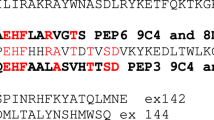Abstract.
Transitin is an avian intermediate filament protein whose transient expression in the progenitor cells of the muscle and nerve tissues is similar to that of mammalian nestin. Both proteins contain an α-helical core domain flanked by a short N-terminal head and a long C-terminal extremity. However, the tail region of transitin is significantly different from that of nestin in that it harbors a unique motif containing more than 50 leucine zipper-like heptad repeats which is not found in any other intermediate filament protein. Despite the absence of introns in this region of the transitin gene, it was reported that different isoforms of the protein were produced by exclusion or inclusion of a number of repeats generated by an unusual splicing mechanism recognizing consensus 5′ and 3′ splice sites contained within the coding sequence of the heptad repeat domain [Napier et al. (1999) J Mol Neurosci 12:11–22]. Two monoclonal antibodies (mAbs) reacting with repeated epitopes of this motif were used to monitor transitin expression during in vitro myogenesis of the quail myogenic cell line QM7. Confocal microscopy revealed that the subcellular domains decorated with mAbs A2B11 and VAP-5 were mutually exclusive: the intermediate filament network visualized with mAb VAP-5 appeared to abut on a submembranous domain defined by mAb A2B11. When QM7 cells were induced to differentiate by switching to medium containing low serum components, an early effect was the local loss of A2B11 cortical staining at the points of cell–cell contacts. The A2B11 signal also disappeared before that of VAP-5 in newly formed myotubes. Unexpectedly, the mutually exclusive staining pattern of the mAbs could not be explained by alternative splicing since both epitopes mapped to a repeated element preceding the consensus 5′ splice sites of the heptad repeat domain. An alternative explanation would be that the central repeat domain of transitin is a polymorphic structure from which different conformations exist depending on the local context. This hypothesis is strengthened by the observation that in cultured neural crest cells, the A2B11 antigen is preferentially expressed by freely migrating crest cells whose intracellular pH and calcium concentrations are different from those of non-migrating cells.
Similar content being viewed by others
Author information
Authors and Affiliations
Additional information
Electronic Publication
Rights and permissions
About this article
Cite this article
Darenfed, H., Ma, X., Davis, L. et al. Molecular polymorphism of the intermediate filament protein transitin. Histochem Cell Biol 116, 397–409 (2001). https://doi.org/10.1007/s00418-001-0333-7
Accepted:
Published:
Issue Date:
DOI: https://doi.org/10.1007/s00418-001-0333-7




